Understanding patents
Don’t be scared of patents. They are not really that difficult to understand.
A patent specification includes the following sections:
Abstract
This section has no legal significance. It is merely a summary of the invention, which is intended to assist a reader quickly to understand the features covered by the patent.
Background of invention
This section similarly has no legal significance. Its purpose is to identify the prior art and highlight the problem(s) that persists, which the invention intends to overcome.
Summary of the invention
This section is supposed to summarise the claims in plain English, but this is seldom the case. Again, this section can be ignored when reviewing a complete patent specification.
Brief description of drawings
The drawings accompanying the specification are merely introduced in this section.
Detailed description of drawings
This part of the specification must “support” the claims. In other words, whatever is mentioned in the claims must be described in this section with reference to the drawings. When reviewing a specification, it is not strictly necessary to read this section. Refer to it when a word or phrase in a claim is unclear or ambiguous.
Claims
This is the most important part of the specification and where the majority of your attention should be directed. The claims define the scope of monopoly granted by the patent. A set of claims typically include independent claims (i.e. claims that do not refer to other claims) and dependent claims (i.e. claims that refer to, and thereby incorporate the features of other claims). As one “goes down” the chain of dependency, the scope of the claims decreases. Generally, dependent claims are inserted to give the applicant “fall back” positions should “higher-ranking” claims later be found to lack novelty. Focus should therefore be directed at the independent claims as these are broadest in scope. A single patent application could include various independent claims to cover the: apparatus; method of using the apparatus; method of making the apparatus; etc.
Drawings
A preferred embodiment of the invention must be illustrated, showing all the features claimed.
Claim example (1)
It is best to explain claims by way of examples.
Let’s take the following cap:
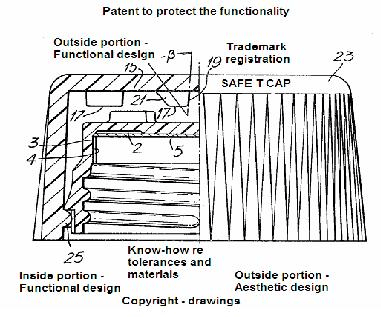
Note: The cap potentially includes various types of intellectual property: certain features of shape can be protected by designs (both aesthetic and functional); the manner in which it works could be protected by a patent, the drawings are protected by copyright, and the secret information (e.g. relating to materials, manufacturing processes and tolerances) comprises know-how.
Assuming that prior art includes 2-part child-proof caps, but that the novel feature of this cap is that the parts lock against rotation when moved axially relative to each other. If we were to draft a claim that covers the invention embodied in the cap, our first attempt may look something like this:
Child-proof closure having:
- an inner portion threadably connectable to a container;
- an outer portion secured to the inner portion;
- locking means for preventing relative rotational movement of the portions;
- the portions being axially movable relative to each other between a locked position wherein the locking means lock the portions against relative rotational movement and an axially spaced position wherein the portions are free to rotate relative to each other; and
- a biasing means for maintaining the outer and inner portions in the axially spaced position.
Remember that the scope of the patent is defined by the claim, so this patent will only prevent competitors from making, importing and selling caps that include all the above features. Presuming that the above claim does not read onto prior art (i.e. does not describe all the features present in an existing product) and is therefore valid, should a competitor make, import or sell a cap including all the above features, irrespective of any additional features his cap may include, his acts will constitute an infringement of the patent.
Now, lets assume that the competitor imports the following cap:
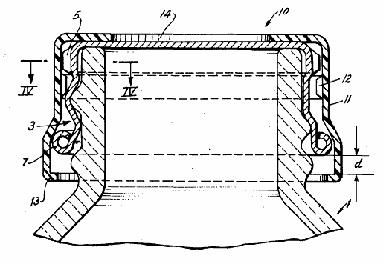
This cap unlocks when the portions are in the axially spaced position, so it will not infringe the above claim. With hindsight, we should have drafted the claim as follows:
Child-proof closure having:
- a threaded inner portion threadably connectable to a container;
- an outer portion secured to the inner portion;
- locking means for preventing relative rotational movement of the portions;
- the portions being axially movable relative to each other between a locked position wherein the locking means lock the portions against relative rotational movement and an unlocked position wherein the portions are free to rotate relative to each other; and
- a biasing means for maintaining the outer and inner portions in the unlocked position.
Notice that the claim no longer specifies in which position the parts are locked against rotation. But will this revised claim cover the following embodiment?
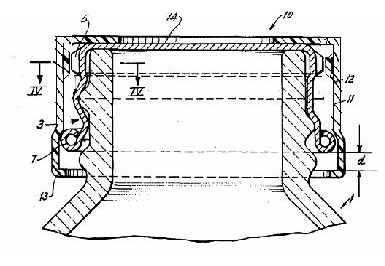
Answer: No, the parts lock and unlock when moved radially relative to each other.
Claim example (2)
You receive the following email and an instruction to file a patent application:
“We are receiving complaints from our users about our measuring spoons, which we supply in sets comprising a number of separate spoons, each having a specific measure such as one teaspoon, one dessertspoon, and the like. The complaints focus on the way in which the various spoons are held together via apertures in their stems by means of a key ring holder. If the spoons are separated from the holder to facilitate use, they get lost. If the spoons are retained on the holder, the spoons not being used make the device difficult to use. The same difficulty generally applies to our sets of measuring cups.
We have now come up with a solution in the form of an adjustable measuring device 10. The measuring device 10 has a channel having a rounded end portion 14. Flanges 16 extend laterally from the upper edges of the channel. We provide an insert 20 having a longitudinal flat plate 22 as a cover and , extending at right angles therefrom, at one end, a tongue 24 fitting snugly within the channel 12. The insert 20 has, along lateral edges, “wrap-around” locating formations 26 embracing the flanges 16 to allow sliding of the insert 20 relative to the channel 12. In use, the longitudinal cover 22 and more specifically the tongue 24 will be adjusted such that the remaining or exposed portion of the channel 12 adjacent the rounded end of portion 14 is of a desired volume. The volume is shown by means of the pointer 28 on the calibration markings 30.”
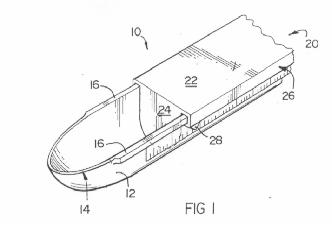
The first questions one asks oneself are:
What is new:
- The manner in which items engage / slide?
- The flanges (16)?
- Wrap around formations (26)?
- The rounded end portion (14)?
- The variable volume cavity (24)?)
- The insert with cover and tongue (22)?
What is necessary:
- Channel?
- Rounded end portion?
- Flanges?
- Wrap-around formations?
- Insert with cover and tongue?
- Measuring tape?
The aim is to draft an independent claim including only the most important new feature that is necessary. The subsequent dependent claims can introduce the additional features.
A first attempt at a claim may look something like this:
A measuring device comprising:
- a receptacle defining a cavity; and
- a graduating member slidably movable within the receptacle to vary the volume of the cavity.
Before putting down the pen, we conduct a quick search, which reveals the following prior art:
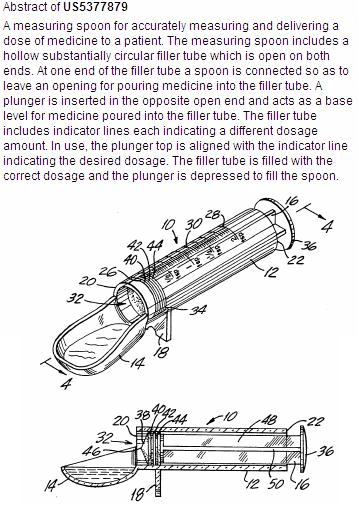
Problem: our claim reads on to the prior art. So, we must revise the claim by adding features:
A measuring device comprising:
- a receptacle defining a cavity;
- a graduating member slideably engageable with the receptacle and having at least a portion protruding into the cavity;
- the receptacle and graduating member defining an opening to the cavity,
- such that relative movement of the graduating member and receptacle varies both the volume of the cavity and the size of the opening to the cavity.
However, could a competitor now safely make / import and sell the following measuring spoon, which is a variant of the patented spoon?
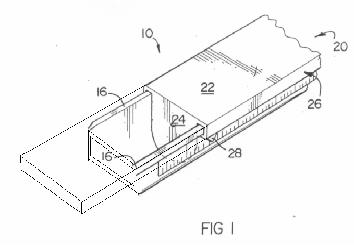
Yes!
Merely changing a feature on a patented product does not necessarily circumvent the patent. It all depends on the claims and the changes made.
Read more: Understanding patent claims
